生产流程图(英文版)
- 格式:doc
- 大小:29.82 KB
- 文档页数:1
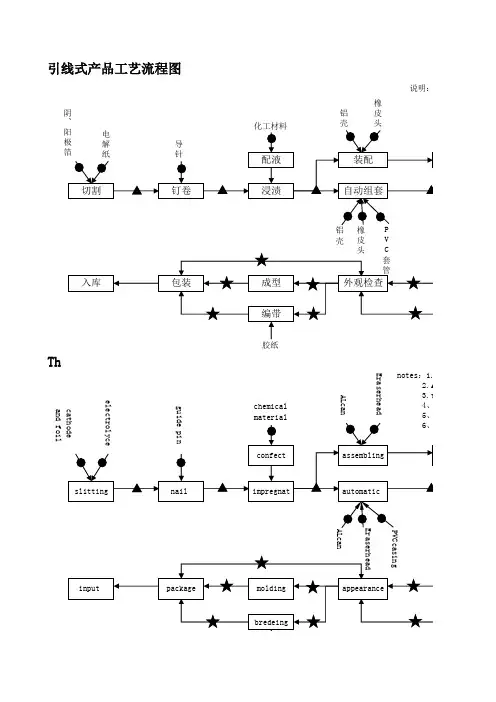
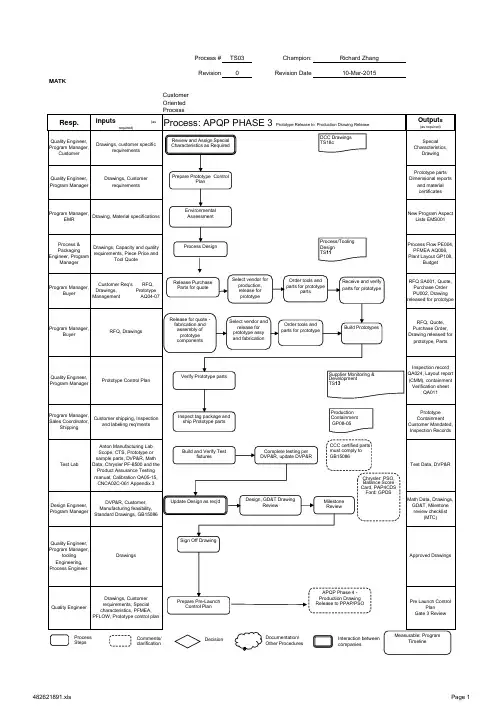
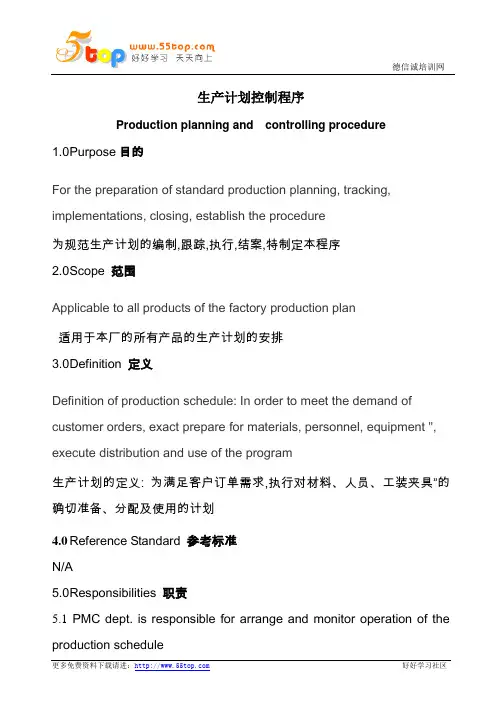
生产计划控制程序Production planning and controlling procedure1.0 P urpose目的For the preparation of standard production planning, tracking, implementations, closing, establish the procedure为规范生产计划的编制,跟踪,执行,结案,特制定本程序2.0 S cope 范围Applicable to all products of the factory production plan适用于本厂的所有产品的生产计划的安排3.0 D efinition 定义Definition of production schedule: In order to meet the demand of customer orders, exact prepare for materials, personnel, equipment ", execute distribution and use of the program生产计划的定义: 为满足客户订单需求,执行对材料、人员、工装夹具”的确切准备、分配及使用的计划4.0Reference Standard 参考标准N/A5.0 R esponsibilities 职责5.1 PMC dept. is responsible for arrange and monitor operation of the production schedule计划部负责安排和监督生产计划的运作5.2 Prod dept. is responsible for execute and finish the productionschedule生产部负责执行和完成生产计划的运作5.3ME dept. is responsible for provide related support of execute the production schedule工程部负责提供执行生产计划运作的相关支持5.4Pur dept. is responsible for provide related material of execute the production schedule采购部负责提供执行生产计划运作的相关物料5.5WH dept. is responsible for distribute related material of execute the production schedule货仓部负责配发执行生产计划运作的相关物料6.0Procedure Flow流程图。
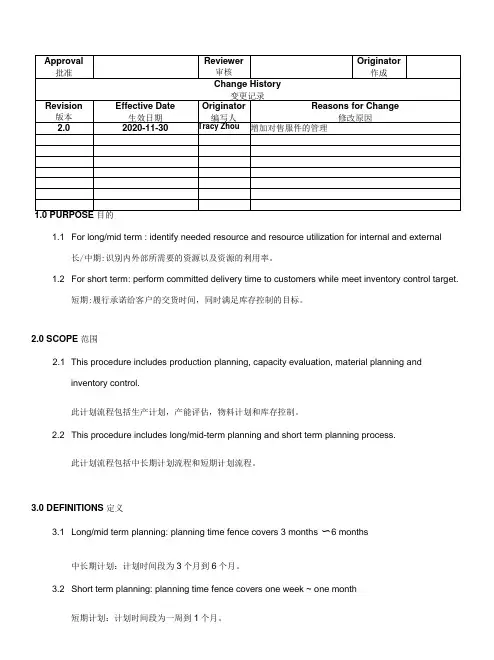
目的1.1 For long/mid term : identify needed resource and resource utilization for internal and external长/中期:识别内外部所需要的资源以及资源的利用率。
1.2 For short term: perform committed delivery time to customers while meet inventory control target.短期:履行承诺给客户的交货时间,同时满足库存控制的目标。
2.0 SCOPE 范围2.1 This procedure includes production planning, capacity evaluation, material planning andinventory control.此计划流程包括生产计划,产能评估,物料计划和库存控制。
2.2 This procedure includes long/mid-term planning and short term planning process.此计划流程包括中长期计划流程和短期计划流程。
3.0 DEFINITIONS 定义3.1 Long/mid term planning: planning time fence covers 3 months 〜6 months中长期计划:计划时间段为3个月到6个月。
3.2 Short term planning: planning time fence covers one week ~ one month短期计划:计划时间段为一周到1个月。
4.0 REFERENCE DOCUMENTS 参考文件4.1 PD-C1-01 Contract Review Procedure 合同评审程序4.2 PD-S2-02 Purchasing management Procedure 采购管理程序4.3 PD-C4-02 Material And Goods Management Procedure 物料管理程序5.1 RECORDS 记录5.1 FN-LG-07 Make Order Form 生产工单5.2 FN-LG-01 Finished goods Shipment Form 销货单5.3 FN-LG-04 Outplant Make Order 委外工单5.2 RESPONSIBILITY 职责6.1 Customer is responsible for providing forecast to logistics, logistics transfer customerpurchasing order to company sales order, contract review.客户负责提供销售预测给物流,物流转换客户采购订单为公司的销售订单,合同评审。
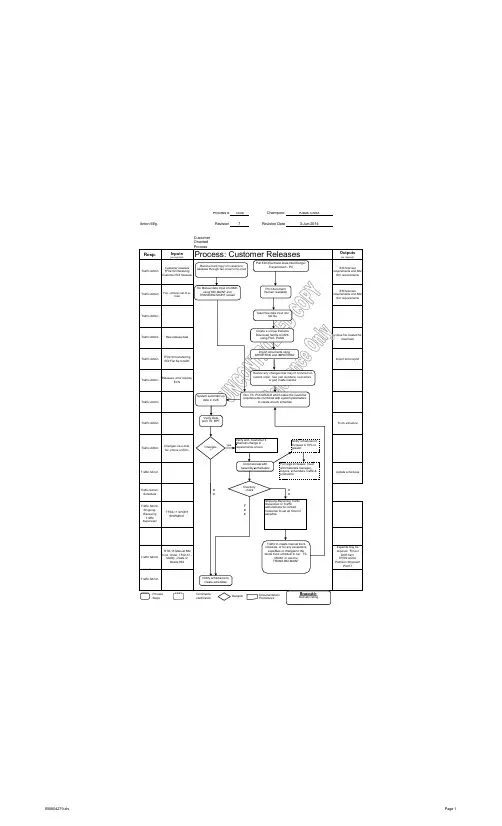
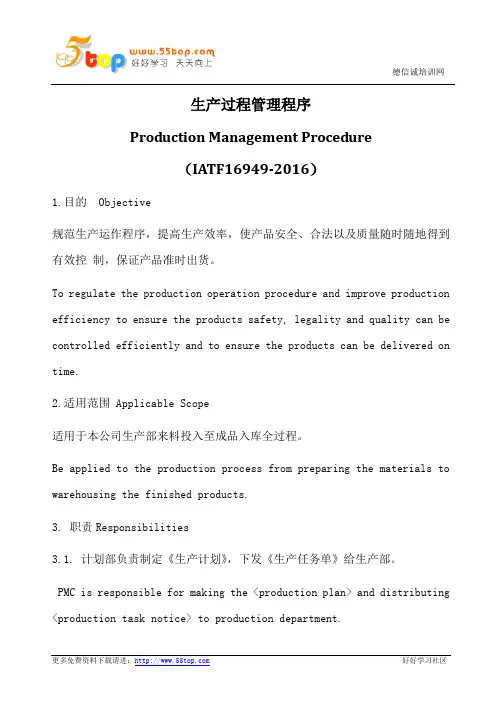
生产过程管理程序Production Management Procedure(IATF16949-2016)1.目的 Objective规范生产运作程序,提高生产效率,使产品安全、合法以及质量随时随地得到有效控制,保证产品准时出货。
To regulate the production operation procedure and improve production efficiency to ensure the products safety, legality and quality can be controlled efficiently and to ensure the products can be delivered on time.2.适用范围 Applicable Scope适用于本公司生产部来料投入至成品入库全过程。
Be applied to the production process from preparing the materials to warehousing the finished products.3. 职责Responsibilities3.1. 计划部负责制定《生产计划》,下发《生产任务单》给生产部。
PMC is responsible for making the <production plan> and distributing <production task notice> to production department.3.2. 生产部每日实行自检、互检制度,负责制程生产的实施与控制。
Production department shall implement self-inspection and mutual inspection everyday and implement and control the production process.3.3.品质部负责产品合法性的确认、质量和安全等整个生产过程品质的监控与跟踪。
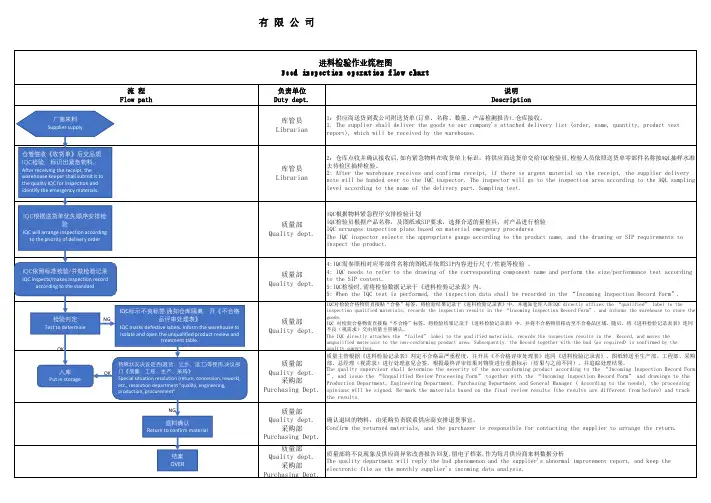
流 程Flow path负责单位Duty dept.说明Description 库管员Librarian 1:供应商送货到我公司附送货单(订单、名称、数量、产品检测报告),仓库接收。
1.The supplier shall deliver the goods to our company's attached delivery list (order, name, quantity, product testreport), which will be received by the warehouse.库管员Librarian 2:仓库点收并确认接收后,如有紧急物料在收货单上标识,将供应商送货单交给IQC检验员,检验人员依照送货单零部件名称按AQL抽样水准去待检区抽样检验。
2: After the warehouse receives and confirms receipt, if there is urgent material on the receipt, the supplier delivery note will be handed over to the IQC inspector. The inspector will go to the inspection area according to the AQL sampling level according to the name of the delivery part. Sampling test.质量部Quality dept.IQC根据物料紧急程序安排检验计划IQC检验员根据产品名称,及图纸或SIP要求,选择合适的量检具,对产品进行检验IQC arranges inspection plans based on material emergency procedures The IQC inspector selects the appropriate gauge according to the product name, and the drawing or SIP requirements toinspect the product.质量部Quality dept.4:IQC需参照相对应零部件名称的图纸并依照SIP内容进行尺寸/性能等检验 。
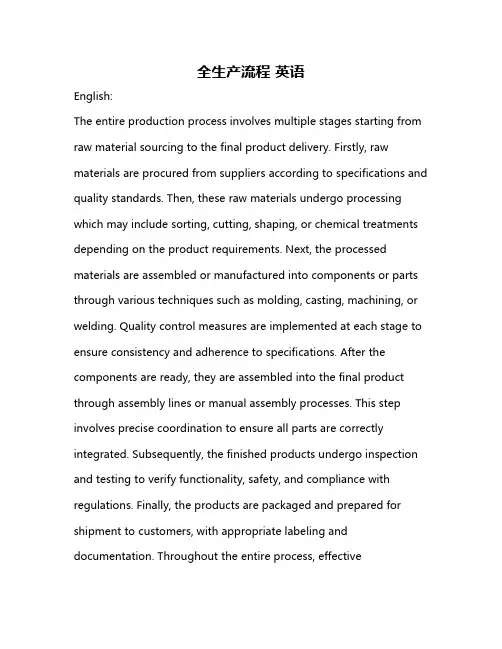
全生产流程英语English:The entire production process involves multiple stages starting from raw material sourcing to the final product delivery. Firstly, raw materials are procured from suppliers according to specifications and quality standards. Then, these raw materials undergo processing which may include sorting, cutting, shaping, or chemical treatments depending on the product requirements. Next, the processed materials are assembled or manufactured into components or parts through various techniques such as molding, casting, machining, or welding. Quality control measures are implemented at each stage to ensure consistency and adherence to specifications. After the components are ready, they are assembled into the final product through assembly lines or manual assembly processes. This step involves precise coordination to ensure all parts are correctly integrated. Subsequently, the finished products undergo inspection and testing to verify functionality, safety, and compliance with regulations. Finally, the products are packaged and prepared for shipment to customers, with appropriate labeling and documentation. Throughout the entire process, effectivecommunication, collaboration, and coordination among different departments and personnel are essential to maintain efficiency and quality.中文翻译:整个生产流程涉及多个阶段,从原材料采购到最终产品交付。
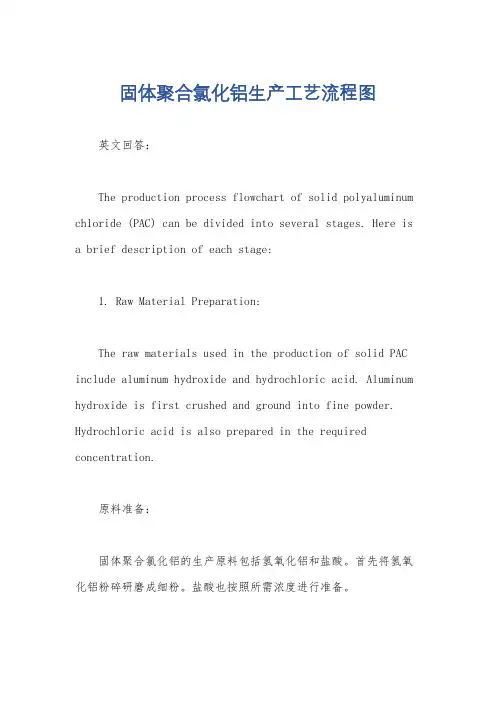
固体聚合氯化铝生产工艺流程图英文回答:The production process flowchart of solid polyaluminum chloride (PAC) can be divided into several stages. Here is a brief description of each stage:1. Raw Material Preparation:The raw materials used in the production of solid PAC include aluminum hydroxide and hydrochloric acid. Aluminum hydroxide is first crushed and ground into fine powder. Hydrochloric acid is also prepared in the required concentration.原料准备:固体聚合氯化铝的生产原料包括氢氧化铝和盐酸。
首先将氢氧化铝粉碎研磨成细粉。
盐酸也按照所需浓度进行准备。
2. Reaction:In this stage, the aluminum hydroxide powder is mixed with the hydrochloric acid solution in a reaction tank. The reaction takes place, resulting in the formation of polyaluminum chloride. The reaction conditions, such as temperature and agitation, are carefully controlled to ensure the desired product quality.反应:在这个阶段,将氢氧化铝粉末与盐酸溶液在反应罐中混合。
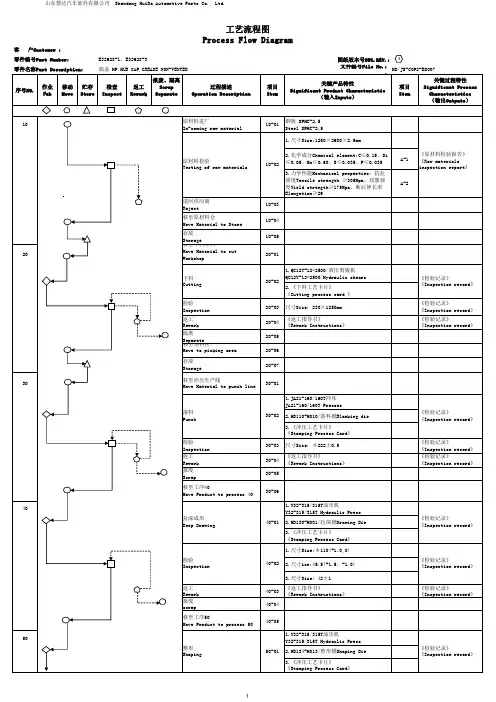
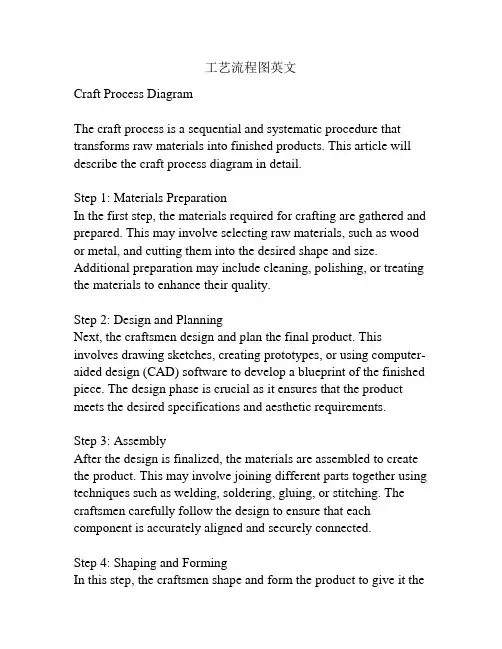
工艺流程图英文Craft Process DiagramThe craft process is a sequential and systematic procedure that transforms raw materials into finished products. This article will describe the craft process diagram in detail.Step 1: Materials PreparationIn the first step, the materials required for crafting are gathered and prepared. This may involve selecting raw materials, such as wood or metal, and cutting them into the desired shape and size. Additional preparation may include cleaning, polishing, or treating the materials to enhance their quality.Step 2: Design and PlanningNext, the craftsmen design and plan the final product. This involves drawing sketches, creating prototypes, or using computer-aided design (CAD) software to develop a blueprint of the finished piece. The design phase is crucial as it ensures that the product meets the desired specifications and aesthetic requirements.Step 3: AssemblyAfter the design is finalized, the materials are assembled to create the product. This may involve joining different parts together using techniques such as welding, soldering, gluing, or stitching. The craftsmen carefully follow the design to ensure that each component is accurately aligned and securely connected.Step 4: Shaping and FormingIn this step, the craftsmen shape and form the product to give it thedesired appearance. This can be done by cutting, bending, hammering, or molding the materials. For example, in woodworking, a carpenter may use a saw to cut wood into specific shapes, while a blacksmith may use a hammer to forge metal into intricate designs.Step 5: Surface TreatmentTo enhance the product's appearance and durability, surface treatment is performed. This may include processes such as sanding, painting, coating, or polishing. For wooden products, sanding is often done to smoothen the surface before applying finishes such as varnish or paint. Metal products may undergo treatments like electroplating or powder coating to protect them from corrosion.Step 6: Quality AssuranceAt various stages of the craft process, quality checks are conducted to ensure that the final product meets the required standards. This entails inspecting the dimensions, specifications, and overall quality of the finished piece. Any defects or imperfections are identified, and corrective actions are taken to rectify them.Step 7: Packaging and DistributionOnce the product passes the quality checks, it is packaged and prepared for distribution. This involves wrapping, labeling, and arranging the finished products in suitable packaging materials. The packaged products are then stored or shipped to retailers or customers.Step 8: Maintenance and RepairAfter the product is delivered to the customer, it may require periodic maintenance or repair. This ensures that the product remains in optimal condition and extends its lifespan. Craftsmen may provide after-sales services to address any issues or damages that arise after the purchase.In conclusion, the craft process diagram involves various steps, starting from materials preparation to maintenance and repair. Each step contributes to the creation of a high-quality finished product. Craftsmanship requires skill, precision, and attention to detail, making it a unique and valuable form of art.。